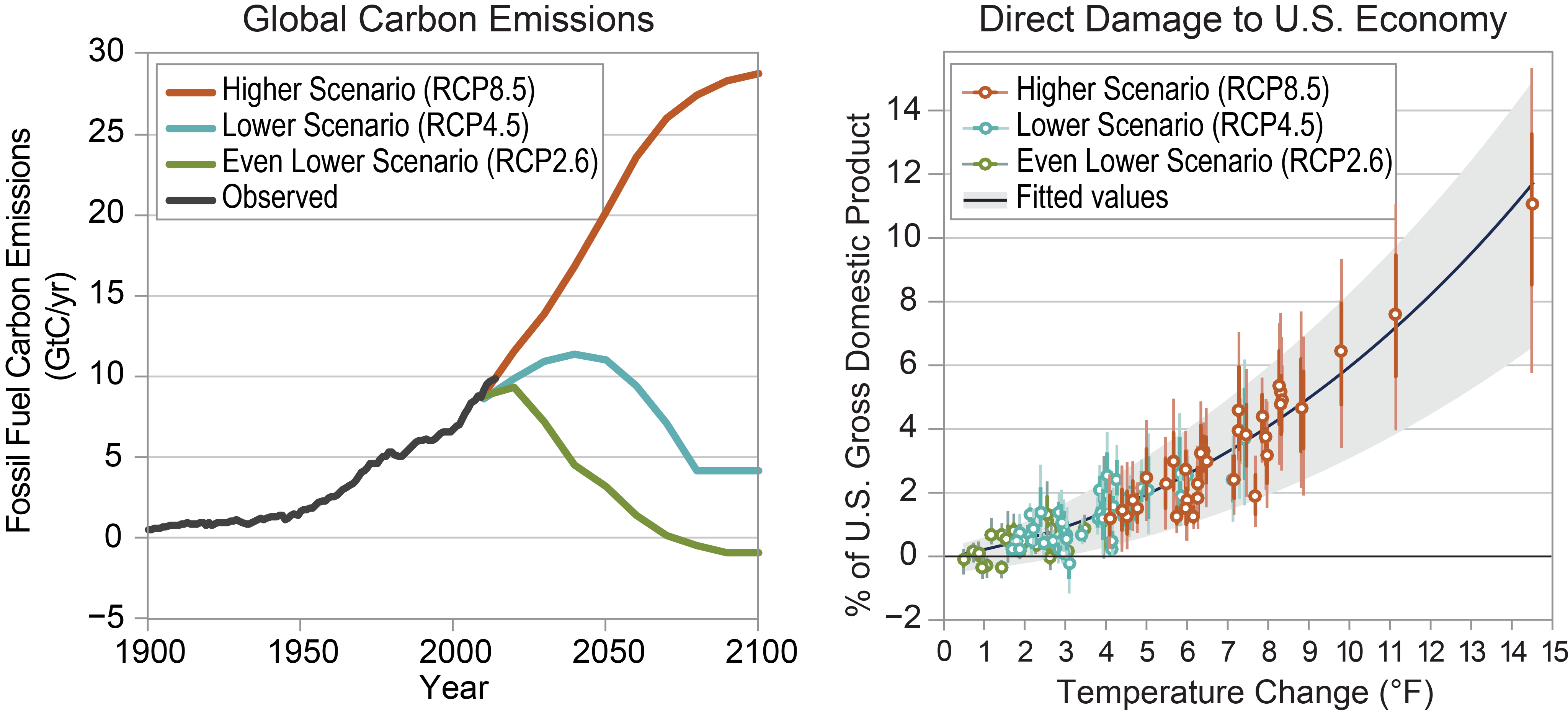The scope for this chapter was determined by the federal Fourth National Climate Assessment (NCA4) Steering Committee, which is made up of representatives from the U.S. Global Change Research Program (USGCRP) member agencies (see App. 1: Process for more information regarding the Steering Committee). The scope was also informed by research needs identified in the Third National Climate Assessment (NCA3) and in subsequent gap analyses.155 Prospective authors were nominated by their respective agency, university, organization, or peers. All prospective authors were interviewed with respect to their qualifications and expertise. Authors were selected to represent the diverse perspectives relevant to mitigation, with the final team providing perspectives from federal and state agencies, nonfederal climate research organizations, and the private sector. The author team sought public input on the chapter scope and outline through a webinar and during presentations at conferences and workshops.
The chapter was developed through technical discussions of relevant evidence and expert deliberation by the report authors during extensive teleconferences, workshops, and email exchanges. These discussions were informed by the results of a comprehensive literature review, including the research focused on estimating the avoided or reduced risks of climate change. The authors considered inputs submitted by the public, stakeholders, and federal agencies and improved the chapter based on rounds of review by the public, National Academies of Sciences, Engineering, and Medicine, and federal agencies. The author team also engaged in targeted consultations during multiple exchanges with contributing authors from other chapters of this assessment, as well as authors of the Climate Science Special Report (CSSR). For additional information on the overall report process, see Appendix 1: Process.
Key Message 1: Mitigation-Related Activities Within the United States
Mitigation-related activities are taking place across the United States at the federal, state, and local levels as well as in the private sector (very high confidence). Since the Third National Climate Assessment, a growing number of states, cities, and businesses have pursued or deepened initiatives aimed at reducing emissions (very high confidence).
Description of evidence base
Since NCA3, state, local, and tribal entities have announced new or enhanced efforts to reduce greenhouse gas (GHG) emissions. While some policies with emissions co-benefits have been eliminated, on net there has been an increase in initiatives aimed at reducing emissions. Figure 29.1 includes several types of state-level efforts and is sourced from Figure ES-3 of the America’s Pledge Phase 1 report, the most comprehensive listing of efforts across sectors currently available. The underlying state information is sourced from the U.S. Department of Energy, Appliance Standards Awareness Project, Open Energy Information, Rethink Food Waste Through Economics and Data, World Resources Institute, State of New York, California Air Resources Board, University of Minnesota, Land Trust Alliance, and the U.S. Forest Service.
U.S. state and local carbon pricing programs have increased in number since NCA3.156 The Regional Greenhouse Gas Initiative has expanded the depth of emissions reductions activities and is considering adding transportation to their scope. California’s cap and trade program started in 2012 and expanded by linking to Quebec and Ontario in 2017. Emissions trading systems are scheduled in Massachusetts and under consideration in Virginia.156
U.S. states have both mandatory and voluntary programs that vary in stringency and impact. For example, 29 states, Washington, DC, and 3 territories have Renewable Portfolio Standards (RPS; https://energy.gov/eere/slsc/renewable-portfolio-standards-resources), which require some portion of electricity to be sourced from renewable energy; while 8 states and 1 territory have voluntary renewable portfolio goals.42,45 Likewise, 20 states have mandatory statewide Energy Efficiency Resource Standards (EERS; https://energy.gov/eere/slsc/energy-efficiency-resource-standards-resources), and 8 states have energy efficiency goals.42 While the number of states with RPS and EERS policies remains similar to that during NCA3, emissions reductions associated with the impact of these policies have and are projected to increase.157 In 2013, 8 states initiated an effort to coordinate implementation of their state zero-emission vehicle programs and have since taken a wide range of actions.158
Federal budget levels for activities that have reduced GHG have remained steady over recent years. There is uncertainty around the implementation of federal initiatives, in part owing to the implementation of Executive Order 13783.40,159 Federal energy-related research and development have several co-benefits, including reduced emissions.15
U.S. companies that report through the Carbon Disclosure Project increasingly (although not comprehensively) reported board-level oversight on climate issues, which rose from 50% in 2011 to 71% in 2017. Likewise, 59 U.S. companies recently committed to set science-based emissions reduction targets.46 U.S. businesses are increasingly pricing carbon.46,160 Corporate procurement of utility-scale solar has grown by an order of magnitude since 2014.47
As indicated in the Education Institutions Reporting Database, a growing number of universities have made emissions reduction commitments or deepened existing commitments161 as well as publicized the progress on their efforts.162
Major uncertainties
Figure 29.1 shows a count of each type of 30 measures across 6 categories, but it does not explore the relative stringency or emissions impact of the measures. The size, scope, time frame, and enforceability of the measures vary across states. Some state efforts and the majority of city efforts are voluntary, and therefore standards for reporting are heterogeneous. Efforts are underway to provide a rigorous accounting of the cumulative scale of these initiatives. Data collection through the America’s Pledge effort is an ongoing, iterative process and, by necessity, involves aggregating different measures into categories. Historically, state, local, and corporate policies change on different cycles.
Description of confidence and likelihood
There is very high confidence that state, local, and private entities are increasingly taking, or are committed to taking, GHG mitigation action. Public statements and collated indices show an upward trend in the number of commitments, as well as the breadth and depth of commitments over the past five years.
Key Message 2: The Risks of Inaction
In the absence of more significant global mitigation efforts, climate change is projected to impose substantial damages on the U.S. economy, human health, and the environment (very high confidence). Under scenarios with high emissions and limited or no adaptation, annual losses in some sectors are estimated to grow to hundreds of billions of dollars by the end of the century (high confidence). It is very likely that some physical and ecological impacts will be irreversible for thousands of years, while others will be permanent (very high confidence).
Description of evidence base
Recent scientific and economic advances are improving the ability to understand and quantify the physical and economic impacts of climate change in the United States, including how those risks can be avoided or reduced through large-scale GHG mitigation. While the projected impacts of climate change across sectors and regions are well documented throughout this assessment, several multisector modeling projects are enabling the comparison of effects through the use of consistent scenarios and assumptions.2,3,4,5 A well-recognized conclusion from the literature produced by these projects is that climate change is projected to adversely affect the U.S. economy, human health, and the environment, each of which is further detailed below. These estimated damages increase over time, especially under a higher scenario (RCP8.5). For sectors where positive effects are observed in some regions or for specific time periods (for example, reduced mortality from extreme cold temperatures or beneficial effects on crop yields), the effects are typically dwarfed by changes happening overall within the sector or at broader scales (for example, comparatively larger increases in mortality from extreme heat or many more crops experiencing adverse effects).2,3,4,5 In Figure 29.2, wildfire is the only sector showing positive effects, a result driven in this particular study by projected shifts to vegetation with longer fire return intervals.2 However, it is important to note that the analysis underlying this result did not quantify the broader economic effects associated with these vegetative shifts, including ecosystem disruption and changes to ecosystem services. See Chapter 6: Forests for a discussion on the weight of evidence regarding projections of future wildfire activity, which generally show increases in annual area burned over time. See Chapter 25: Southwest for a discussion on aridification toward the end of this century under high emissions.
There is robust and consistent evidence that climate change is projected to adversely affect many components of the U.S. economy. Increasing temperatures, sea level rise, and changes in extreme events are projected to affect the built environment, including roads, bridges, railways, and coastal development. For example, coastal high tide flooding is projected to significantly increase the hours of delay for vehicles.163 Annual damages to coastal property from sea level rise and storm surge, assuming no adaptation, are projected to range in the tens to hundreds of billions of dollars by the end of the century under RCP8.5 (Ch. 8: Coastal).2,5 Projected annual repair costs in order for roads, bridges, and railways to maintain levels of service in light of climate change range in the billions to tens of billions of dollars under RCP8.5.2,164 Numerous studies suggest that regional economies can also be at risk, especially when they are tied to environmental resources or ecosystem services that are particularly vulnerable to climate change. For example, projected declines in coral reef-based recreation152,165,166 would lead to decreases in tourism revenue; shorter seasons for winter recreation would likely lead to the closure of ski areas and resorts;167,168,169,170 and increased risks of harmful algal blooms can limit reservoir recreation (Ch. 3: Water).171,172
An increasing body of literature indicates that impacts to human health are likely to have some of the largest effects on the economy. Studies consistently indicate that climate-driven changes to morbidity and mortality can be substantial.72,100,173,174,175,176 In some sectors, the value of health damages is estimated to reach hundreds of billions of dollars per year under RCP8.5 by the end of the century. A large fraction of total health damages is due to mortality, quantified using the Value of a Statistical Life (VSL) approach based on standard VSL values used in federal government regulatory analysis.177 For example, annual damages associated with extreme temperature-related deaths are estimated at $140 billion by the end of the century under RCP8.5, while lost wages from extreme temperatures, especially for outdoor industries, are projected at $160 billion per year by 2090.2 Adaptive actions, including physiological adaptation and increased availability of air conditioning, are projected to reduce extreme temperature mortality by approximately half; however, the implementation costs of those adaptations were not estimated. Although less studied compared to the research on the direct effects of temperature on health, climate-driven impacts to air quality72,178 and aeroallergens173,179 are also projected to have large economic effects, due to increases in medical expenditures (such as emergency room visits) and premature mortality (Ch. 13: Air Quality).
Multiple lines of research have also shown that some climate change impacts will very likely be irreversible for thousands of years. For some species, the rate and magnitude of climate change projected for the 21st century is projected to increase the risk of extinction or extirpation (local-scale extinction) from the United States.180,181,182,183 Coral reefs, coldwater fish, and high-elevation species are particularly vulnerable (Ch. 9: Oceans; Ch. 7: Ecosystems). The rapid and widespread climate changes occurring in the Arctic and Antarctic are leading to the loss of mountain glaciers and shrinking continental ice sheets.69,184 The contribution of this land ice volume to the rate of global sea level rise is projected to affect U.S. coastlines for centuries (Ch. 8: Coastal).19,30,185
Major uncertainties
This Key Message reflects consideration of the findings of several recent multisector modeling projects (e.g., Hsiang et al. 2017, O’Neill et al. 2017, EPA 2017, Houser et al. 2015)2,3,4,5 released since NCA3. Despite these improvements to quantify the physical and economic impacts of climate change across sectors, uncertainty exists regarding the ultimate timing and magnitude of changes, particularly at local to regional scales. The sources of uncertainty vary by sector and the modeling approaches applied. Each approach also varies in its capacity to measure the ability of adaptation to reduce vulnerability, exposure, and risk. While the coverage of impacts has improved with recent advancements in the science, many important climate change effects remain unstudied, as do the interactions between sectors (Ch. 17: Complex Systems).85 Finally, as climate conditions pass further outside the natural variability experienced over past several millennia, the odds of crossing thresholds or tipping points (such as the loss of Arctic summer sea ice) increase, though these thresholds are not well represented in current models.22,142
Description of confidence and likelihood
There is very high confidence that climate change is projected to substantially affect American livelihoods and well-being in the future compared to a future without climate change. The evidence supporting this conclusion is based on agreement across a large number of studies analyzing impacts across a multitude of sectors, scenarios, and regions. The literature clearly indicates that the adverse impacts of climate change are projected to substantially outweigh the positive effects. Although important uncertainties exist that affect our understanding of the timing and magnitude of some impacts, there is very high confidence that some effects will very likely lead to changes that are irreversible on human timescales.
Key Message 3: Avoided or Reduced Impacts Due to Mitigation
Many climate change impacts and associated economic damages in the United States can be substantially reduced over the course of the 21st century through global-scale reductions in greenhouse gas emissions, though the magnitude and timing of avoided risks vary by sector and region (very high confidence). The effect of near-term emissions mitigation on reducing risks is expected to become apparent by mid-century and grow substantially thereafter (very high confidence).
Description of evidence base
There are multiple lines of research and literature available to characterize the effect of large-scale GHG mitigation in avoiding or reducing the long-term risks of climate change in the United States. Recent multisector impacts modeling projects, all of which feature consistent sets of scenarios and assumptions across analyses, provide improved capabilities to compare impacts across sectors and regions, including the effect of global GHG mitigation in avoiding or reducing risks.2,3,4,5 The results of these coordinated modeling projects consistently show reductions in impacts across sectors due to large-scale mitigation. For most sectors, this effect of mitigation typically becomes clear by mid-century and increases substantially in magnitude thereafter. In some sectors, mitigation can provide large benefits. For example, by the end of the century, reduced climate change under a lower scenario (RCP4.5) compared to a higher one (RCP8.5) avoids (on net, and absent additional risk reduction through adaptation) thousands to tens of thousands of deaths per year from extreme temperatures,2,5 hundreds to thousands of deaths per year from poor air quality,2,72 and the loss of hundreds of millions of labor hours.2,3,5
Beyond these multisector modeling projects, an extensive literature of sector-specific studies compares impacts in the United States under alternative scenarios. A careful review of these studies, especially those published since the Third National Climate Assessment, finds strong and consistent support for the conclusion that global GHG mitigation can avoid or reduce the long-term risks of climate change in the United States. For example, mitigation is projected to reduce the risk of adverse impacts associated with extreme weather events,29,186 temperature-related health effects,99,100,175 agricultural yields,187,188,189 and wildfires.73,190,191
The finding that the magnitude and timing of avoided risks vary by sector and region, as well as due to changes in socioeconomics and adaptive capacity, is consistently supported by the broad literature base of multisector analyses (e.g., Hsiang et al. 2017, O’Neill et al. 2017, EPA 2017, Houser et al. 20152,3,4,5) and focused sector studies (e.g., Melvin et al. 2016, Neumann et al. 201471,77). Complex spatial patterns of avoided risks are commonly observed across sectors, including for human health effects (e.g., Fann et al. 2015, Sarofim et al. 2016100,178), agriculture (e.g., Beach et al. 2015192), and water resources (e.g., Chapra et al. 2017, Wobus et al. 2017, EPA 2013167,171,193).
The weight of evidence among studies in the literature indicates that the difference in climate impact outcomes between different scenarios is more modest through the first half of the century,2,4,5,9 as the human-forced response may not yet have emerged from the noise of natural climate variability.6 In evaluating and quantifying multisector impacts across alternative scenarios, the literature generally shows that the effect of near-term mitigation in avoiding damages increases substantially in magnitude after 2050.2,4,5 For example, mitigation under RCP4.5 is projected to reduce the number of premature deaths and lost labor hours from extreme temperatures by 24% and 21% (respectively) by 2050, and 58% and 48% by 2090.2 For coastal impacts, where inertia in the climate system leads to smaller differences in rates of sea level rise across scenarios, the effects of near-term mitigation only become evident toward the end of the century (Ch. 8: Coastal).2,5,19
Major uncertainties
Quantifying the multisector impacts of climate change involves a number of analytic steps, each of which has its own potential sources of uncertainty. The timing and magnitude of projected future climate change are uncertain due to the ambiguity introduced by human choices, natural variability, and scientific uncertainty, which includes uncertainty in both scientific modeling and climate sensitivity. One of the most prominent sources involves the projection of climate change at a regional level, which can vary based on assumptions about climate sensitivity, natural variability, and the use of any one particular climate model. Advancements in the ability of climate models to resolve key aspects of atmospheric circulation, improved statistical and dynamic downscaling procedures, and the use of multiple ensemble members in impact analyses have all increased the robustness of potential climate changes that drive impact estimates described in the recent literature. However, key uncertainties and challenges remain, including the structural differences between sectoral impact models, the ability to simulate future impacts at fine spatial and temporal resolutions, and insufficient approaches to quantify the economic value of changes in nonmarket goods and services.85 In addition, the literature on economic damages of climate change in the United States is incomplete in coverage, and additional research is needed to better reflect future socioeconomic change, including the ability of adaptation to reduce risk.
Description of confidence and likelihood
There is very high confidence that large-scale reductions in GHG emissions throughout the 21st century are projected to reduce the level of climate change projected to occur in the United States, along with the adverse impacts affecting human health and the environment. Across the literature, there are limited instances where mitigation, compared to a higher emissions scenario, does not provide a net beneficial outcome for the United States. While the content of this chapter is primarily focused on the 21st century, confidence in the ability of mitigation to avoid or reduce impacts improves when considering impacts beyond 2100.
Key Message 4: Interactions Between Mitigation and Adaptation
Interactions between mitigation and adaptation are complex and can lead to benefits, but they also have the potential for adverse consequences (very high confidence). Adaptation can complement mitigation to substantially reduce exposure and vulnerability to climate change in some sectors (very high confidence). This complementarity is especially important given that a certain degree of climate change due to past and present emissions is unavoidable (very high confidence).
Description of evidence base
Global-scale reductions in GHG emissions are projected to reduce many of the risks posed by climate change. However, Americans are already experiencing, and will continue to experience, impacts that have already been committed to because of past and present emissions.5,9 In addition, multisector modeling frameworks demonstrate that mitigation is unlikely to completely avoid the adverse impacts of climate change.2,3,4,5,27 These factors will likely necessitate widespread adaptation to climate change (Ch. 28: Adaptation); an expanding literature consistently indicates potential for the reduction of long-term risks and economic damages of climate change.2,4,5,194 However, it is important to note that adaptation can require large up-front costs and long-term commitments for maintenance (Ch. 28: Adaptation), and uncertainty exists in some sectors regarding the applicability and effectiveness of adaptation in reducing risk.101
Because of adaptation’s ability to reduce risk in ways that mitigation cannot, and vice versa, the weight of the evidence shows that the two strategies can act as complements. Several recent studies jointly model the effects of mitigation and adaptation in reducing overall risk to the impacts of climate change in the United States, focusing on infrastructure (e.g., Larsen et al. 2017, Melvin et al. 2016, Neumann et al. 2014)71,77,195 and agriculture (e.g., Kaye and Quemada 2017, Challinor et al. 2014, Lobell et al. 2013).108,109,111 Exploration of this mitigation and adaptation nexus is also advancing in the health sector, with both mitigation and adaptation (such as behavioral changes or physiological acclimatization) being projected to reduce deaths from extreme temperatures100 in both the higher and lower emissions scenarios that are the focus of this chapter. Similarly, energy efficiency investments are reducing GHG emissions and operating costs and improving resilience to future power interruptions from extreme weather events (Ch. 14: Human Health). While more studies exploring the joint effects of mitigation and adaptation are needed, recent literature finds that combined mitigation and adaptation actions can substantially reduce the risks posed by climate change in several sectors.2,103,104 However, several studies highlight that mitigation and adaptation can also interact negatively. While these studies are more limited in the literature, sectors exhibiting potential negative co-effects from mitigation and adaptation include the bioenergy–water resource nexus114 and changes in electricity demand and supply in response to increased use of air conditioning.2,117
Major uncertainties
It is well understood that adaptation will likely reduce climate risks and that adaptation and mitigation interact. However, there are uncertainties regarding the magnitude, timing, and regional/sectoral distribution of these effects. Developing a full understanding of the interaction between mitigation and adaptation, with detailed accounting of potential positive and negative co-effects, is an important research objective that is only beginning to be explored in the detail necessary to inform effective implementation of these policies. Quantifying the effectiveness of adaptation requires detailed analyses regarding the timing and magnitude of how climate is projected to affect people living in the United States and their natural and built environments. As such, the uncertainties described under Key Messages 1 and 2 are also relevant here. Further, uncertainty exists regarding the effectiveness of adaptation measures in improving resilience to climate impacts. For some sectors, such as coastal development, protection measures (for example, elevating structures) have been well studied and implemented to reduce risk. However, the effectiveness of adaptation in other sectors, such as the physiological response to more intense heat waves, is only beginning to be understood.
Description of confidence and likelihood
There is very high confidence that the dual strategies of mitigation and adaptation being taken at national, regional, and local levels provide complementary opportunities to reduce the risks posed by climate change. Studies consistently find that adaptation would be particularly important for impacts occurring over the next several decades, a time period in which the effects of large-scale mitigation would not yet be easily recognizable. However, further analysis is needed to help resolve uncertainties regarding the timing and magnitude of adaptation, including the potential positive and negative co-effects with mitigation.





